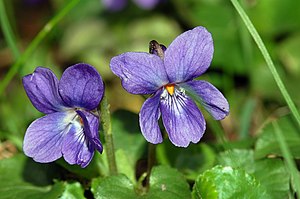Note: This is a project under development. The articles on this wiki are just being initiated and broadly incomplete. You can Help creating new pages.
Difference between revisions of "Viola odorata - Violet wood"
(Created page with "thumb|right|''File:Viola odorata fg01.JPG'' '''Viola odorata''' is a species of the genus Viola native to Europe and Asia, but has also been i...") |
(No difference)
|
Revision as of 10:55, 25 January 2017
Viola odorata is a species of the genus Viola native to Europe and Asia, but has also been introduced to North America and Australia. It is commonly known as wood violet,[1] sweet violet, English violet, common violet, florist's violet, or garden violet.[2] The plant is known as Banafsa, Banafsha or Banaksa in India. It is a hardy herbaceous flowering perennial.
Contents
Description
V. odorata can be distinguished by the following characteristics:
- the flowers are aromatic,
- the flowers are normally either dark violet or white,
- the leaves and flowers are all in a basal rosette,
- the style is hooked (and does not end with a rounded appendage),
- the leaf-stalks have hairs which point downwards, and
- the plant spreads with stolons (above-ground shoots).
These perennial flowers can mature at a height of 4 to 6 inches and a spread of 8 to 24 inches. The species can be found near the edges of forests or in clearings; it is also a common "uninvited guest" in shaded lawns or elsewhere in gardens.
Uses
- The sweet scent of this flower has proved popular, particularly in the late Victorian period, and has consequently been used in the production of many cosmetic fragrances and perfumes.
- Poucher wrote that the flowers were widely cultivated both in Europe and the East for their fragrance, with both the flowers and leaves being separately collected and extracted for fragrance, and flowers also collected for use in confectionery galenical syrup and in the production of medicine.
- The leaves are edible and commonly used in salads. Real violet flower extract is available for culinary uses, especially in European countries, but it is expensive.
- In herbal medicine, V. odorata has been used for a variety of respiratory ailments, insomnia, and skin disorders.[3]
